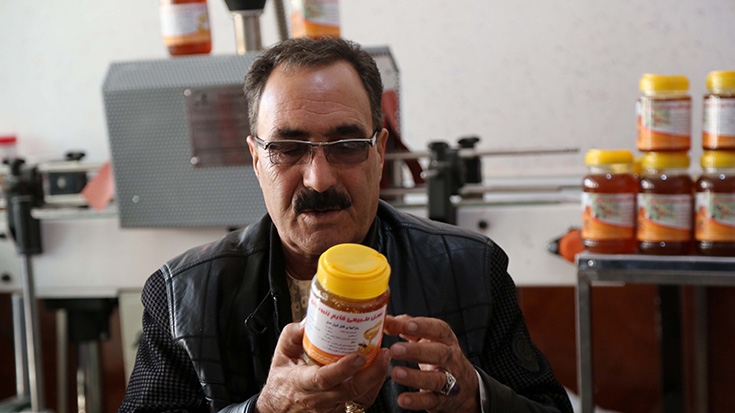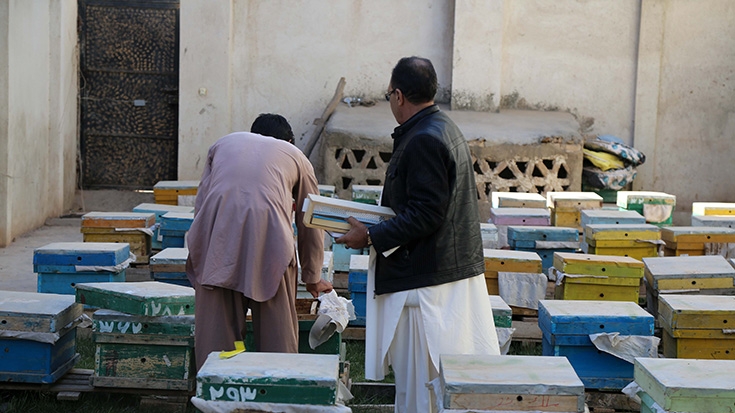Dr. Rahimi started his beekeeping business in 2009 with only 10 hives. He has invested nearly $80,000 in the business, and today he owns two apiaries and also raises bees at home.
But according to Dr Rahimi, he would not have succeeded without the help of the Afghanistan Rural Enterprise Development Program (AREDP). “Whatever we have is because of AREDP. Our production has crossed the 3,000 kilogram (kg) line and our bee hives total 400,” says Dr. Rahimi, who believes the exposure visits organized by AREDP have benefited their business “more than billions of Afghanis”.
“As part of its mandate to support rural entrepreneurs, AREDP facilitated exposure visits for us to places like Jalalabad (the capital city of Nangarhar Province), where we met with beekeepers who shared with us their knowhow on bee reproduction, honey harvesting and much more. It was only after returning from this visit that I increased the number of my bee boxes to 100,” says Dr. Rahimi.
AREDP, implemented by the Ministry of Rural Rehabilitation and Development and supported by the World Bank and Afghanistan Reconstruction Trust Fund, seeks to enhance economic mobilization and activities by organizing the rural poor into Savings Groups, Village Savings & Loan Associations and Enterprise Groups. The project provides technical support to these groups so as to build a financial discipline through savings and internal lending practices, and technical support to enterprises.
Started in 2010, AREDP works towards strengthening market linkages and value chains for rural enterprises by providing technical support to over 1,345 Enterprise Groups (63 percent female) and 256 Small Medium Enterprises (13 percent female) that have been selected for their potential as key drivers of rural employment and income generation.
Demand in domestic and export markets
Honey production in Herat Province occurs twice a year: first in mid-summer and then during early autumn. Beekeepers say they harvest 20 kg of honey, at a minimum, from each beehive. The price of pure honey is just under $20 in local markets in Herat Province.
According to Dr Rahimi, the quality of the honey produced in Herat Province is such that he receives purchase orders not only domestically but even from other countries including Iran. Given that Iran is a major producer and exporter of honey worldwide, the demand for Afghan honey in Iran is a great achievement in itself, says Dr Rahimi.
“In Afghanistan we supply honey to different stores in many cities while we also have our own chain stores where we sell honey. Occasionally, we receive orders from Dubai and Turkey as well, not to mention our regular exports to Iran which range between 40 to 50 kg per week,” he remarks.
It is not only producers but also, more importantly, consumers who are happy with the quality of Afghan honey. Behzad, a young man living in Herat city, says he regularly buys honey for his family of five because he is well informed about its benefits.
“The quality of our domestic honey is undisputed. It makes you physically fit and is a cure for many illnesses. That is why I try to buy honey from wholesalers or the chain stores owned by the beekeeping farms,” he says. “If we maintain the current quality, there will soon be a high demand for our honey outside the country.”
Another beneficiary is Nesar Ahmad Mohammadi, 20, who is in charge of honey collection and packaging in an apiary in Herat Province. He is paid around $170 per month for his work. Nesar Ahmad along with his colleagues fill up dozens of honey jars weighing half a kilogram and 1 kg on a daily basis for supply to the market.
“It takes two to three months from the time honey is harvested from hives until it is marketed. We need to organize our activities carefully so that we always have honey for sale and for daily packaging based on market requirements,” he says.


